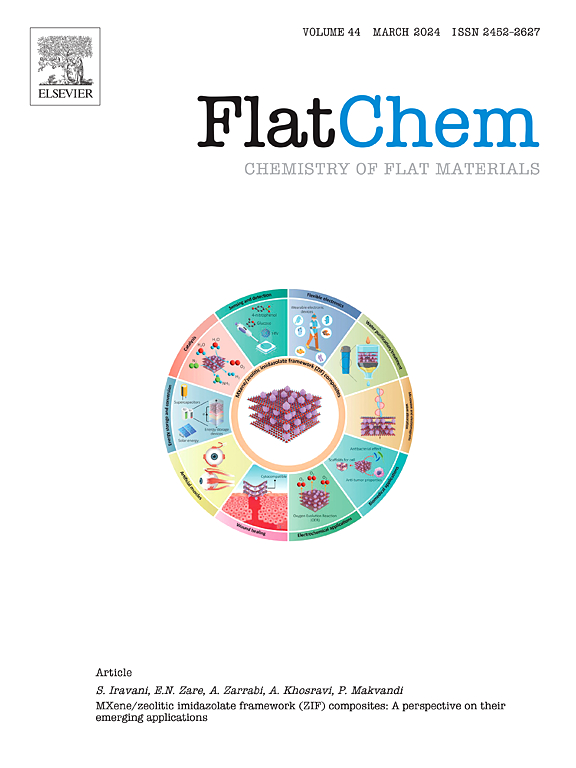用噻吩甲醛和金团簇固定一次性碳电极提高苦味酸炸药在废水和土壤样品中的传感性能
IF 6.2
3区 材料科学
Q2 CHEMISTRY, PHYSICAL
引用次数: 0
摘要
制备了一种具有成本效益、易于制作、一次性、高选择性的电化学平台,用于实际样品中危险爆炸性苦味酸的灵敏检测。这种创新的电极是通过将多壁碳纳米管、金簇和噻吩甲醛固定在石墨表面来构建的。利用循环伏安法、扫描电镜、能量色散x射线光电子能谱和x射线光电子能谱技术对制造的传感器进行了综合表征。该电极具有良好的分析性能,校准灵敏度为26.44μA.L.mg−1。cm−2,极低的检出限为12 μg/L,在25 ~ 400 μg/L和1 ~ 16 mg/L范围内具有较宽的线性范围。与裸电极相比,该电极的电流增加了297%。这种增强归因于类似于亨利反应和酸碱相互作用的机制。此外,该传感器表现出出色的重复性和再现性(相对标准偏差(RSD) < 5%)以及令人印象深刻的稳定性,在7天后保持97.3%的信号。为保证准确度,采用土壤元素(UME EnvCRM 03)和废水元素(UME CRM 1204)认证标准物质对方法进行验证,回收率在96.88% ~ 103.56%之间,RSD值小于4.50%。这些结果证实了所开发的传感器和分析方法的高可靠性和准确性。本文章由计算机程序翻译,如有差异,请以英文原文为准。

Boosted sensing performance of picric acid explosive in wastewater and soil samples using disposable carbon electrodes immobilized with thiophenecarboxaldehyde and gold clusters
A cost-effective, easily fabricated, disposable, and highly selective electrochemical platform was fabricated for the sensitive detection of hazardous explosive picric acid in real samples. This innovative electrode was constructed by immobilizing multi-walled carbon nanotubes, gold clusters, and thiophenecarboxaldehyde onto a graphite surface. Comprehensive characterization of the manufactured sensor was carried out using cyclic voltammetry, scanning electron microscopy, energy-dispersive X-ray spectroscopy, and X-ray photoelectron spectroscopy techniques. The proposed electrode exhibited remarkable analytical performance, achieving a high calibration sensitivity of , an exceptionally low detection limit of 12 μg/L, and broad linear ranges of 25–400 μg/L and 1–16 mg/L. The fabricated electrode exhibited a 297 % increase in current compared to the bare electrode. This enhancement was attributed to mechanisms analogous to the Henry reaction and acid-base interactions. In addition, the sensor demonstrated excellent repeatability and reproducibility (relative standard deviation (RSD) <5 %) along with impressive stability, maintaining 97.3 % of its signal after seven days. To ensure accuracy, the proposed method was validated using Elements in Soil (UME EnvCRM 03) and Elements in Wastewater (UME CRM 1204) certified reference materials, yielding recovery rates between 96.88 % and 103.56 % and RSD values lower than 4.50 %. These results confirm the high reliability and accuracy of the developed sensor and the analytical method.
求助全文
通过发布文献求助,成功后即可免费获取论文全文。
去求助
来源期刊

FlatChem
Multiple-
CiteScore
8.40
自引率
6.50%
发文量
104
审稿时长
26 days
期刊介绍:
FlatChem - Chemistry of Flat Materials, a new voice in the community, publishes original and significant, cutting-edge research related to the chemistry of graphene and related 2D & layered materials. The overall aim of the journal is to combine the chemistry and applications of these materials, where the submission of communications, full papers, and concepts should contain chemistry in a materials context, which can be both experimental and/or theoretical. In addition to original research articles, FlatChem also offers reviews, minireviews, highlights and perspectives on the future of this research area with the scientific leaders in fields related to Flat Materials. Topics of interest include, but are not limited to, the following: -Design, synthesis, applications and investigation of graphene, graphene related materials and other 2D & layered materials (for example Silicene, Germanene, Phosphorene, MXenes, Boron nitride, Transition metal dichalcogenides) -Characterization of these materials using all forms of spectroscopy and microscopy techniques -Chemical modification or functionalization and dispersion of these materials, as well as interactions with other materials -Exploring the surface chemistry of these materials for applications in: Sensors or detectors in electrochemical/Lab on a Chip devices, Composite materials, Membranes, Environment technology, Catalysis for energy storage and conversion (for example fuel cells, supercapacitors, batteries, hydrogen storage), Biomedical technology (drug delivery, biosensing, bioimaging)
 求助内容:
求助内容: 应助结果提醒方式:
应助结果提醒方式:


